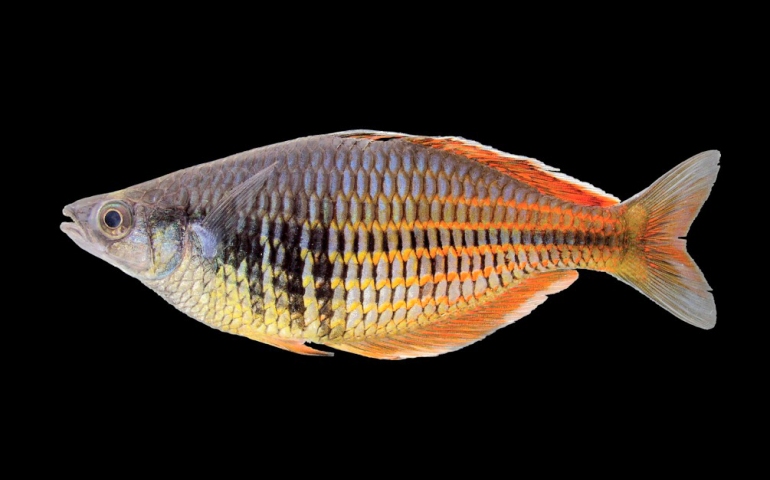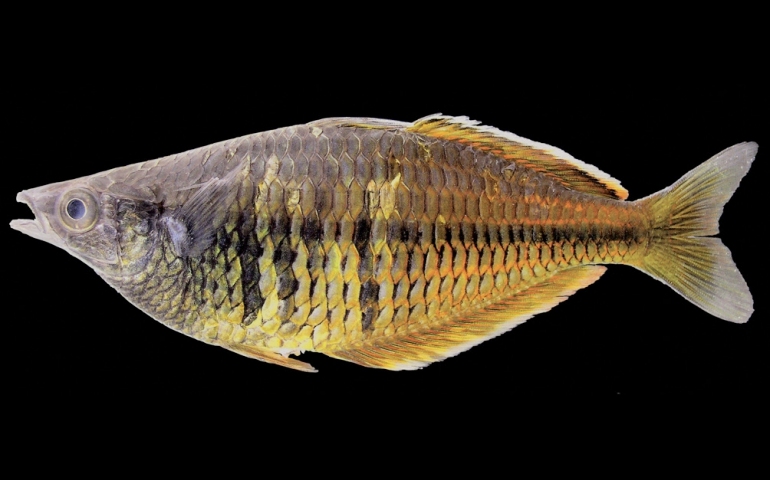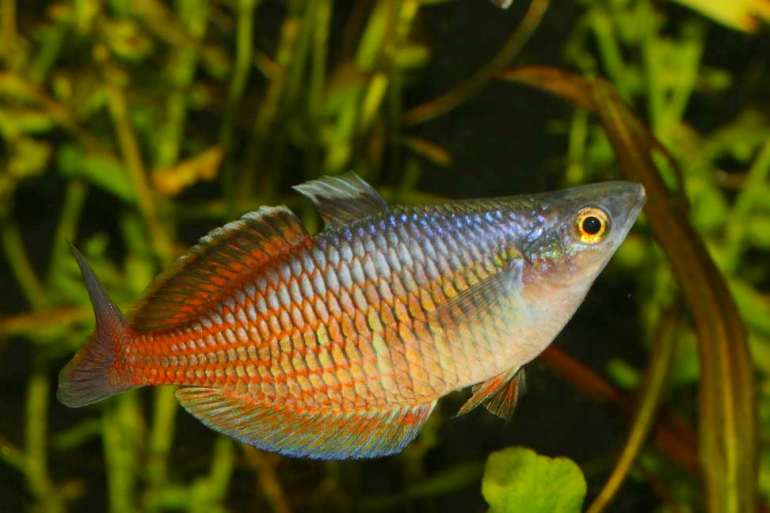|
 |
Melanotaenia ajamaruensis (male) [Kaliwensi River] - photo© Laurent Pouyaud |
Allen and Cross, 1980
Ajamaru Rainbowfish
Species Summary
From October 1954 through to May 1955 Marinus Boeseman took part in a collecting expedition for the Rijksmuseum van Natuurlijke Historie to Netherlands New Guinea (West Papua). Among the places he visited was Lake Sentani, Tami River, Biak Island, Lake Jamoer (Yamur), Wissel Lakes, Ajamaru Lakes (Ayamaru), Lake Ajtinjo, Merauke and the Digul River. This collection included many rainbowfishes, but a thorough study of the collection or description of the fishes was never made by Boeseman.
As part of his preparation for the revision of the rainbowfish family, Gerald Allen studied the Boeseman collection of 1954-55 during 1975 and 1977. He discovered no less than four new rainbowfish species, which he described in 1980 together with Norbert Cross. These species were Melanotaenia boesemani, M. ajamaruensis, M. japenensis and Glossolepis pseudoincisus.
From field notes it was stated that Melanotaenia ajamaruensis have a metallic blue to yellowish or green with orange and yellow longitudinal stripes and dark scale edges. The body is ovate and laterally compressed. Mature males have a higher first dorsal fin, which overlaps the origin of the second dorsal fin when depressed. They grow to a length of around 11 cm; males are usually deeper bodied than females. They were named "ajamaruensis" with reference to the Ajamaru Lakes, the type locality and only known collection site for this species at that time.
In 1980 Allen & Cross described M. ajamaruensis as a species of Melanotaenia with the following combination of characters: dorsal rays IV to VI, 15 to 19; anal rays I, 21 to 27; pectoral rays 13 to 15; horizontal scale rows 7 or 8; vertical scale rows 34 to 37; predorsal scales 13 to 16 preopercle scales 9 to 16; colour generally reddish-brown on back and anterior half of body grading to yellow or tan posteriorly with series of red-brown horizontal stripes on side, in life ground colour metallic blue to yellowish or green with yellow longitudinal stripes.
The interesting thing about M. ajamaruensis is their remarkable similarity to M. boesemani. Nonetheless, M. boesemani is readily separable from M. ajamaruensis on the basis of soft ray counts for the second dorsal and anal fins. The former species has 10 to 14 (usually 12 or 13) dorsal rays and 17 to 23 (usually 18 to 21) anal rays compared with 15 to 19 (usually 15 to 17) and 21 to 27 (usually 22 to 24) for M. ajamaruensis. Although these species possess a similar colouration and general shape, the stripes on the sides tend to be more pronounced in M. ajamaruensis, particularly the mid-lateral one and the stripe just below it. M. ajamaruensis further differs from M. boesemani by being more slender, and by having the first dorsal fin origin in front (by about one half eye diameter) of the anal fin origin compared to the approximately even position of these fins in M. boesemani.
 |
Melanotaenia ajamaruensis (female) [Kaliwensi River] - photo© Laurent Pouyaud |
Distribution & Habitat
In 1980 Allen & Cross described M. ajamaruensis from museum specimens reported to have been collected by Marinus Boeseman in March 1955 from the vicinity of Ajamaroe (Ajamaru) on Jow Lake, in the interior of the Vogelkop Peninsula, Netherlands New Guinea. Boeseman (1963) gave a description and map of this location as follows: Ajamaroe Lakes is actually widened parts of the west-east streaming Ajamaroe River, situated about in the centre of the Vogelkop Peninsula. From west to east, the first lake, called Jow, has a length of 7 km and a width of 2 km; the second, Semitoe or Maroemèga, a length of only 2 km and a width of 1½ km; the third, Jate or Hain, a length of 3 km and a width of not even 1 km. The lakes are surrounded by a low marshy plain of varying width and, beyond the plain, by hills and mountains reaching heights up to about 1500 m, covered with forest. Several small streams enter the lakes which have an altitude of about 250 m above sea level, a depth of rarely more than 3 m, clear water almost stagnant except near entering rivers and outlets, pH approximately 6.4, a soft muddy bottom mostly covered with a rich aquatic vegetation, while the low shores and coastal plains are usually covered with secondary vegetation consisting primarily of grasses and low shrubs. This whole complex belongs to the Kais River drainage system which empties on the southwestern coast of the peninsula into the Ceram Sea.
The Ajamaru Lakes region is located about 120 km east-southeast of Sorong, at the headwaters of the Ajamaru River in the centre of the Vogelkop Peninsula at the western extremity of New Guinea. The region contains a number of small freshwater lakes and associated marshes. The largest lake, Lake Ajamaru drains east via Lake Hain (comprising two smaller lakes) into the Ajamaru River, an upper tributary of the Kais River that eventually flows into the Ceram Sea to the south. The lakes are positioned centrally on the Ajamaru Plateau, a heavily karstified region. The average elevation of the plateau is reported as 350 metres above sea level. The Ajamaru Plateau extends for 20-30 km to the south and south-west of the lakes before giving way to a broad zone of relict alluvial landforms dissected by wide flooded river valleys.
 |
Melanotaenia ajamaruensis (male) - photo© Andreas Wagnitz |
Remarks
In November 1982, Gerald Allen had the opportunity to collect live specimens during a visit to the remote Ajamaru Lakes region. Heiko Bleher, a well-known aquarium fish collector, had accompanied Gerald Allen on the trip and was able to transport a number of live specimens captured during the expedition back to Europe, whereupon they were subsequently bred and distributed in the aquarium hobby as M. boesemani. However, they did not find any specimens of M. ajamaruensis. At the time it was thought that females of M. boesemani were M. ajamaruensis. The natural colours of M. ajamaruensis were not known. The type specimens preserved in the Leiden museum were the only ones that had so far been collected. Perhaps M. ajamaruensis never occurred in Lake Ajamaru in the first place?
In 2007, a number of surveys were conducted by the Papuan National Marine and Fisheries Research, the Academy of Fishery Sorong, and the Institut de recherche pour le développement (IRD) Jakarta in five bioregions of West Papua. During the survey some rainbowfish specimens were collected that were considered to fit the type specimens of M. ajamaruensis as described by Allen and Cross in 1980. They were collected in an upstream section of the Kaliwensi River, about 5 km west of Lake Ajamaru. The river was 10-15 metres wide; 1-3 metres deep. The water was clear and fast-flowing over gravel and boulders with no aquatic vegetation. Water conditions report were: Temperature 24.7°C; pH 7.88 and Conductivity 217 µS/cm. It is thought that Marinus Boeseman collected in this region in 1955 and that this is where the type specimens of M. ajamaruensis came from. Perhaps Marinus Boeseman thought the river connected to Lake Ajamaru?
The Kaliwensi River is an old outlet to the western side of the lake, but does not flow into the lake. It is thought that it may have flowed into Lake Ajamaru in the past, but is only connected today by subterranean outlets. There is no connection between the lake and the river and M. boesemani doesn't occur in the river. This was the only known location of M. ajamaruensis until 2013. In 2013 live specimens of M. ajamaruensis were collected for the aquarium hobby by Hans-Georg Evers and Jeffrey Christian from both the Kaliwensi and Soum rivers.
Literature
Allen G.R. and N.J. Cross (1980) Description of Five New Rainbowfishes (Melanotaeniidae) from New Guinea. Records of the Western Australian Museum 8(3): 377-96.
Allen G.R. and M. Boeseman (1982) A collection of freshwater fishes from western New Guinea with descriptions of two new species (Gobiidae and Eleotridae). Records of the Western Australian Museum, 10(2): 67-103.
Boeseman M. (1956) The Lake Resources of Netherlands New Guinea. South Pacific Commission Quarterly Bulletin 6(1): 23-25.
Boeseman M. (1956) Fresh-water sawfishes and sharks in Netherlands New Guinea. Science 123: 222-223.
Boeseman M. (1963) Notes on the fishes of Western New Guinea. Zoologische Mededelingen Leiden 38(14): 221-242.
Evers H. (2014) Boeseman's Rainbowfish and its rare new cousin. AMAZONAS 3(5): 42-51 [English edition].
Pouyaud L. (2007) Expedition Papua 2007 Rapport De Mission. IRD Indonesie Department Resources Vivantes - UR 175.
Adrian R. Tappin
Updated June, 2016



|

